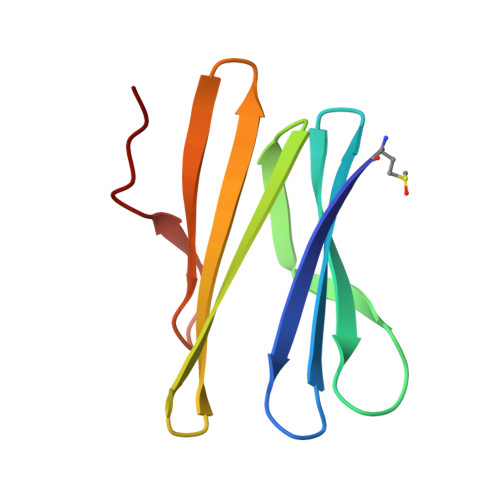Deciphering the Glycan Preference of Bacterial Lectins by Glycan Array and Molecular Docking with Validation by Microcalorimetry and Crystallography.
Topin, J., Arnaud, J., Sarkar, A., Audfray, A., Gillon, E., Perez, S., Jamet, H., Varrot, A., Imberty, A., Thomas, A.(2013) PLoS One 8: 71149
- PubMed: 23976992
- DOI: https://doi.org/10.1371/journal.pone.0071149
- Primary Citation of Related Structures:
3ZW1 - PubMed Abstract:
Recent advances in glycobiology revealed the essential role of lectins for deciphering the glycocode by specific recognition of carbohydrates. Integrated multiscale approaches are needed for characterizing lectin specificity: combining on one hand high-throughput analysis by glycan array experiments and systematic molecular docking of oligosaccharide libraries and on the other hand detailed analysis of the lectin/oligosaccharide interaction by x-ray crystallography, microcalorimetry and free energy calculations. The lectins LecB from Pseudomonas aeruginosa and BambL from Burkholderia ambifaria are part of the virulence factors used by the pathogenic bacteria to invade the targeted host. These two lectins are not related but both recognize fucosylated oligosaccharides such as the histo-blood group oligosaccharides of the ABH(O) and Lewis epitopes. The specificities were characterized using semi-quantitative data from glycan array and analyzed by molecular docking with the Glide software. Reliable prediction of protein/oligosaccharide structures could be obtained as validated by existing crystal structures of complexes. Additionally, the crystal structure of BambL/Lewis x was determined at 1.6 Å resolution, which confirms that Lewis x has to adopt a high-energy conformation so as to bind to this lectin. Free energies of binding were calculated using a procedure combining the Glide docking protocol followed by free energy rescoring with the Prime/Molecular Mechanics Generalized Born Surface Area (MM-GBSA) method. The calculated data were in reasonable agreement with experimental free energies of binding obtained by titration microcalorimetry. The established predictive protocol is proposed to rationalize large sets of data such as glycan arrays and to help in lead discovery projects based on such high throughput technology.
Organizational Affiliation:
CERMAV- Centre national de la recherche scientifique UPR5301 (affiliated to Université Joseph Fourier and ICMG), BP53, 38041 Grenoble, France ; Département de Chimie Moléculaire, UMR- Centre national de la recherche scientifique 5250 & ICMG FR 2607, Université Joseph Fourier, BP 53, 38041 Grenoble, France.



















